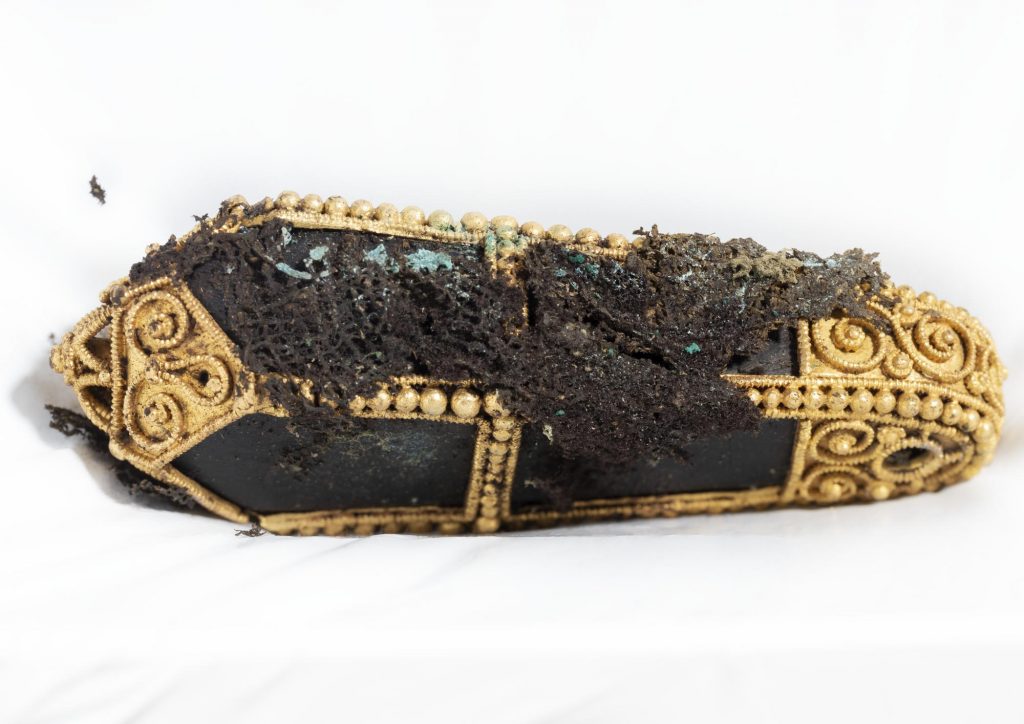In 2017, hundreds of generous donors saved the Galloway Hoard for the nation. But their generosity did more than save the hoard; it enabled us to start conserving and researching it, opening a unique window into Viking-age Scotland’s relationship with Britain, Ireland and the wider world, over a millennium ago.
This is the first of two blog posts about what we’ve learned so far and how my research is progressing. You’ll get a glimpse behind the scenes of our work and some of the avenues of research I’ve been exploring.
This is undoubtedly the most intriguing assemblage of objects I could ever hope to work on. I remember clearly the trepidation of transporting the fragile elements of the hoard (and the relief on safe arrival!) when we reunited the hoard at the National Museums Collection Centre for the first time in January 2018. As well as the silver, gold, glass, minerals and Anglo-Saxon jewellery there was a range of organic materials preserved in the hoard (wood, leather and textiles) and some of these were still wrapping precious objects. Many were contained in a silver-gilt lidded vessel, itself wrapped in layers of textile. Inside the vessel, the exotic materials and objects include a carved rock crystal jar, gold jewels and pendants, and strangest of all… two curious balls of dirt! (But more of these in part two…)
Half the world away: exotic crystal and gold
One of the most mysterious objects within the Hoard is the carved rock crystal jar covered with elaborate gold-work and wrapped in a silk-lined, leather pouch. There are so many questions to ask of this object. Where was it made for instance? The technology needed to carve rock crystal was relatively rare in the ancient world. In the later 10th century AD the centres of production were in the Islamic Caliphate, in modern day Iraq and Egypt, but this presents a conundrum because the Galloway Hoard was buried sometime around AD900, perhaps 50-100 years before this boom in rock crystal production. Was the jar a precociously early product of Islamic rock crystal production or was it an older object? If not from the Islamic world, where did this rock crystal come from? I contacted Professor Avinoam Sholem, of Columbia University in New York, an expert on Islamic rock crystals, who suggested I look at the Metropolitan Museum of Art’s collection. It was to be just the start of a long journey.

In June 2018, I was in New York on other museum business, but this also allowed me to follow Professor Sholem’s advice. The Met was my first big museum experience when I was teenager, the first major museum I could visit on a regular basis. It was so vast and such an eclectic collection I would wander the galleries whenever I could – it is probably where I began dreaming about working in a museum and learning about the rich heritage of humanity.
The opportunity to visit behind the scenes and examine some of their reserve collection was one I couldn’t miss. The Islamic collection wasn’t one I might have previously expected to be examining, but this is the joy of the Galloway Hoard – it throws up surprising possibilities! As is usually the case when in a museum’s reserve collection, I saw more than I bargained for and another unexpected avenue of research opened up…
While we were removing one of the trays of rock crystal objects from storage, I noticed a tray of gold jewellery underneath. Something occurred to me relating to one of the other items in the hoard – a large pendant comprising a carefully shaped, multifaceted black stone encased in gold filigree framework. This pyramid cap also has an unusual hollow dome of filigree on top, and it was this feature that I could see on the gold jewellery beneath the tray of rock crystals. I was then whisked off to another department for a discussion with experts studying Islamic gold jewellery. Thus a new question arose – would the Black-stone gold pendant in the Galloway Hoard turn out to be another piece of exotic, luxury metalwork, perhaps an import from the east?

Even with the treasures they work with every day, the various experts I met at The Met were intrigued by the Hoard and its potential. The gold specialists pored over the pictures I had of the ‘Black-stone’ pendant, and they were also fascinated with what I could show them of the goldwork on the Galloway Hoard rock crystal jar – where did that come from? Islamic rock crystals that survive in collections like the Met never have their original gold fittings, so the Met colleagues were excited by the possibilities of what our rock crystal might tell them about the collections they were studying. The technical details of its goldwork could provide clues about the life of this object, when it was made and where it was from, or even whether it was a re-used object – rock crystals are often re-made into new objects. Clues from a hoard with good dating evidence like the Galloway Hoard could become important reference points for scholars studying gold across Early Medieval Europe, and beyond. The international importance of the Galloway Hoard shone in front of us and we still did not know how far tracing this golden thread would take us.
